
Cubic Boron Nitride (cBN) and Its Applications
Cubic Boron Nitride (cBN) is a synthetic material that has garnered significant attention in various industries due to its exceptional physical and chemical properties. It is a crystalline form of boron nitride (BN) and is structurally similar to diamond, making it one of the hardest materials known.
Properties of Cubic Boron Nitride
- Hardness: cBN is second only to diamond in hardness, making it ideal for cutting, grinding, and abrasive applications.
- Thermal Stability: Unlike diamond, cBN remains stable at high temperatures and does not oxidize in the presence of oxygen. This makes it suitable for applications involving high thermal conditions.
- Chemical Resistance: cBN is resistant to chemical attacks from acids and alkalis, further enhancing its versatility.
- Electrical Insulation: It is an excellent electrical insulator while maintaining good thermal conductivity.
- High Thermal Conductivity: cBN efficiently dissipates heat, which is beneficial in high-power applications.
Production of cBN
Cubic Boron Nitride is typically synthesized using high-pressure, high-temperature (HPHT) methods. The process involves transforming hexagonal boron nitride (hBN), a softer form of BN, into its cubic form by subjecting it to extreme pressure and temperature. Additives, such as alkali or alkaline earth metal catalysts, are often used to facilitate the conversion.
Applications of cBN
- Abrasive Tools:
- cBN is extensively used in manufacturing grinding wheels and cutting tools. Its hardness and thermal stability allow it to work on tough materials like hardened steels and superalloys.
- Cutting Tools:
- Machine tools made with cBN coatings or inserts can sustain high-speed operations and withstand thermal stress, making them suitable for precision machining.
- Electronics:
- Due to its excellent thermal conductivity and electrical insulating properties, cBN is used as a heat spreader in high-power electronic devices.
- Coatings:
- cBN coatings are applied to enhance the wear resistance of components used in demanding environments, such as aerospace and automotive industries.
- Thermal Management:
- In microelectronics, cBN’s high thermal conductivity helps manage heat dissipation in compact, high-performance devices.
- Research and Development:
- Its unique properties make cBN a subject of study in advanced material science for potential applications in quantum computing and other emerging technologies.
Advantages of cBN Over Diamond
While diamond is harder, cBN offers several advantages:
- Higher thermal stability, which prevents degradation at elevated temperatures.
- Better performance in ferrous material machining due to diamond’s tendency to react with iron at high temperatures.
Future Prospects
As industries demand materials with enhanced performance and durability, cBN’s role is expected to grow. Advances in synthesis methods aim to lower production costs and improve quality, broadening its accessibility and applications. The integration of cBN into composite materials and its potential role in next-generation electronics also present exciting opportunities.
In conclusion, cubic boron nitride is a remarkable material with diverse applications across industries. Its unique combination of hardness, thermal stability, and chemical resistance ensures its continued importance in advancing technology and industrial efficiency.
